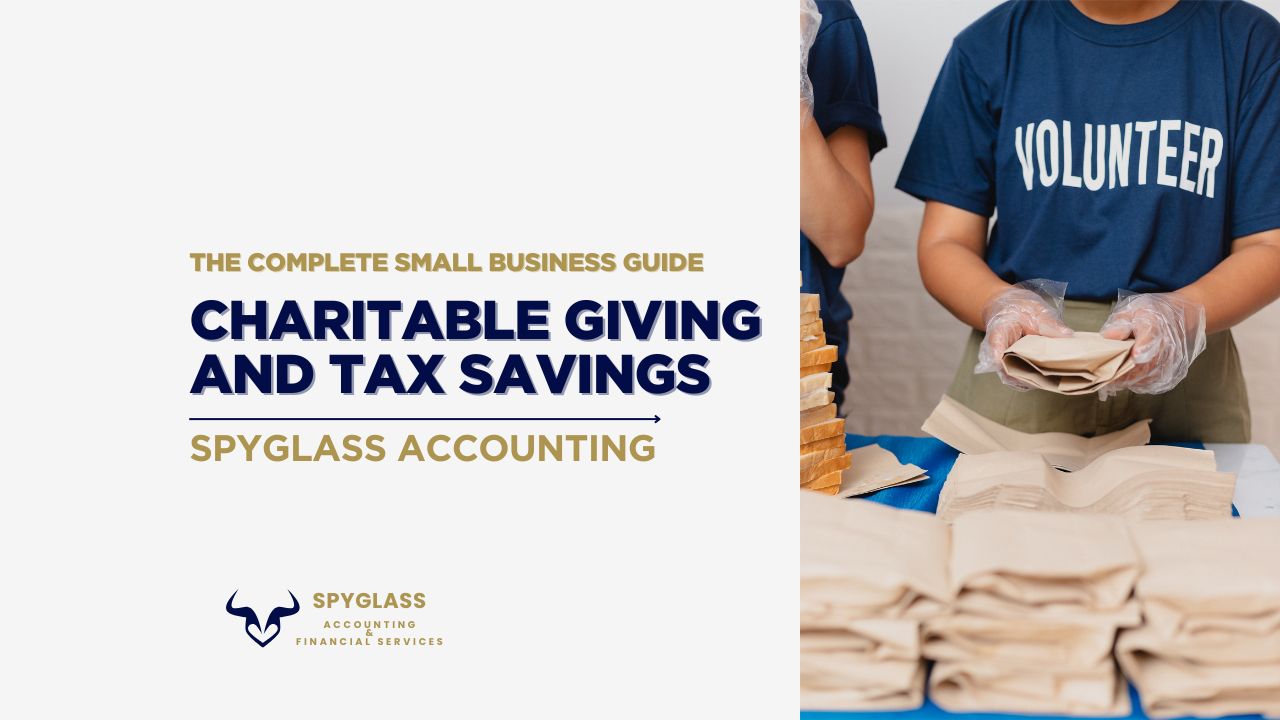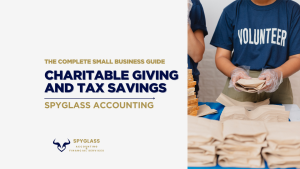
Charitable Giving and Tax Savings: The Complete Small Business Guide
Introduction: Why Charitable Giving is a Smart Business Move
In 2025, small businesses are increasingly leveraging charitable giving not just to support causes they care about—but also to reduce taxable income, boost brand reputation, and engage employees.
But with changing IRS rules and complex deduction limits, how can you maximize tax benefits while making a real impact?

This guide covers:
✔ Tax-deductible donation strategies (cash, goods, sponsorships)
✔ 2025 IRS limits and compliance
✔ How different business structures (LLC, S-Corp, C-Corp) benefit
✔ Common mistakes to avoid
✔ Tools to track and optimize donations
By the end, you’ll know how to give generously while keeping more money in your business.
How Charitable Donations Reduce Taxes
Tax Deductions vs. Tax Credits
- Deduction: Reduces taxable income (e.g., a $1,000 donation lowers taxable income by $1,000).
- Credit: Directly reduces tax owed (rarer for donations).
2025 IRS Limits on Charitable Deductions
| Business Type | Deduction Limit | Key Rules |
| Sole Proprietors/LLCs | Up to 60% of AGI | Must itemize (standard deduction: $14,600 single / $29,200 joint) |
| S-Corps/Partnerships | Passes through to owners | Same as sole proprietors |
| C-Corps | Up to 10% of taxable income | Deducted at corporate level |
Example: A C-Corp with $100K profit can deduct $10K in donations.

Tax-Smart Ways to Donate
Option 1: Cash Donations
- Best for: Quick, straightforward giving.
- Requirements:
- Donation to 501(c)(3) organizations (verify via IRS Tax Exempt Organization Search).
- Receipts for donations over $250.
Option 2: Donating Goods/Inventory
- Fair market value deduction (e.g., donating $5K worth of laptops = $5K deduction).
- Special rule: Businesses donating food inventory can deduct up to 15% of taxable income.
Option 3: Sponsorships (Marketing Deductions)
- Not a charity? Classify as advertising expense if you get branding (e.g., event banners).
- Example: Paying $2K to sponsor a local 5K race with your logo = 100% deductible as marketing.
Option 4: Donor-Advised Funds (DAFs)
- How it works: Contribute to a DAF (e.g., Fidelity Charitable), get an immediate tax deduction, then distribute funds later.
- Best for: “Bunching” multiple years of donations to exceed the standard deduction.
Business Structure Matters
Pass-Through Entities (LLCs, S-Corps, Partnerships)
- Donations flow to owners’ personal tax returns.
- Only beneficial if you itemize deductions (otherwise, no tax savings).
C-Corporations
- Deduct donations up to 10% of taxable income directly on corporate taxes.
- Carry forward excess deductions for 5 years.

What You Can’t Deduct
❌ Political donations
❌ Gifts to individuals (e.g., GoFundMe)
❌ Volunteer time (but out-of-pocket expenses like mileage at 14¢/mile are deductible)
❌ Raffle tickets/silent auction payments (only the amount above fair market value)
Maximizing Deductions: Advanced Strategies
Strategy 1: Bunching Donations
- Problem: Standard deduction is high ($29,200 for couples in 2025).
- Solution: “Bunch” 2–3 years of donations into one year to itemize.
Example:
- Year 1: Donate $15K (itemize).
- Years 2–3: Donate $0 (take standard deduction).
Strategy 2: Donating Appreciated Stock
- Avoid capital gains tax on stocks held over 1 year.
- Deduct full market value (e.g., donate stock worth $10K originally bought for $2K = $10K deduction, $0 capital gains).
Strategy 3: QCDs for Business Owners Over 70.5
- Qualified Charitable Distributions (QCDs): Donate IRA funds tax-free (up to $105K/year).
Recordkeeping & Compliance
IRS Documentation Requirements
| Donation Amount | Required Proof |
| Under $250 | Bank record/receipt |
| $250–$500 | Written acknowledgment from charity |
| Over $500 | IRS Form 8283 (noncash donations) |
| Over $5,000 | Professional appraisal (for property) |
Pro Tip: Get professional help from Spyglass Accounting & Financial Services to maximize tax benefits.

Common Mistakes to Avoid
Mistake #1: Overvaluing Noncash Donations
- IRS red flag: Claiming $10K for used office furniture worth $2K.
- Fix: Use independent appraisals for high-value items.
Mistake #2: Missing Deadlines
- Donations must be made by Dec. 31 for that year’s deduction.
Mistake #3: Ignoring State Rules
- Example: California allows extra credits for food bank donations.
Tools to Simplify Charitable Giving
| Tool | Best For |
| Gusto | Tracking payroll deductions for charity |
| Donorbox | Accepting donations on your website |
| Charity Navigator | Vetting nonprofits |
| Fidelity Charitable | Donor-advised funds |
Conclusion: Giving Back While Growing Your Business
Charitable giving isn’t just good karma—it’s a smart financial strategy. By:
✔ Choosing tax-efficient donation methods (stock, DAFs, sponsorships)
✔ Tailoring giving to your business structure
✔ Keeping meticulous records
…you can support your community and reduce your tax bill.
Need Help? Spyglass Accounting specializes in tax-smart charitable strategies. Book a consultation today!
